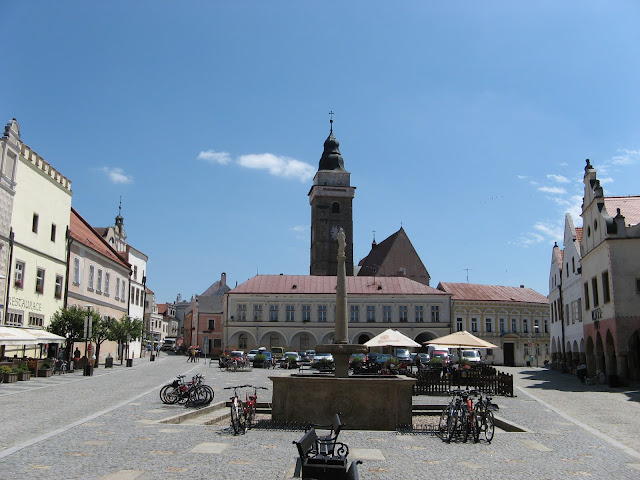Located just one kilometre from the Austrian border and surrounded by rolling green hills, Slavonice is one of the most captivating small towns in the Czech Republic. Since it is still off the radar for most international tourists, the town retains a relaxed provincial feel fused with a dose of artistic and cultural flair due to the many Czech artists who have taken up residence and opened studios and galleries in the historic buildings. Found at the point where the historical regions of Moravia, Bohemia and Austria meet, the town has traditionally been considered part of Moravia but today it is included in the region of South Bohemia.
With two squares jam-packed with ornate buildings smothered in sgraffito facades and nary a concrete building in sight, it's easy to see why Slavonice is a cut above the average Czech border town. The facades are the most impressive and extensive to be found on Czech soil, and they are among the finest anywhere in the former lands of the Austro-Hungarian empire.
The town went through a prolonged period of riches and prosperity lasting from the 14th to 16th centuries with its place on the main trading route between Prague and Vienna guaranteeing a steady stream of commerce to fund the construction of grand renaissance buildings. However, the main trade route was eventually moved to the east passing through the Czech frontier town of Znojmo, and the boom times came to a close in Slavonice.
The town's population was predominantly German-speaking before World War II, but the end of the war brought the mass expulsion of the German population from the Czech lands and the population of Slavonice dropped to a fraction of its former size. During the Communist period from 1948 to 1989 Czechs were not encouraged to resettle in the houses left vacant by the former German inhabitants, so the town became a ghostly shell of its former self.
Under the Communists the frontier with Austria was a highly restricted military zone as part of the iron curtain, and as a result Slavonice was essentially cocooned and prevented from growing or developing. Today this can be considered a blessing, since it effectively protected the town from having any ugly and tasteless concrete buildings constructed in its midst by Communist planners.
Nowadays, Slavonice has developed a strong reputation as a haven for Czech artists and writers who wish to escape to a beautiful corner of the countryside for creative inspiration far from the capital. There are several studios and workshops which have set up shop, and international artists, especially from Austria, have taken notice and begun to frequent the town as well.
In the early 1990's both Slavonice and the nearby town of Telč were promoting themselves as potential UNESCO heritage site candidates, but at the last minute the town council in Slavonice decided to withdraw its bid, so only Telč was placed on the UNESCO list in 1992. I expect that the townsfolk and artists in Slavonice simply decided that they preferred to keep their town low-key and liveable, and to let Telč handle the tour buses and mainstream international attention.
Slavonice is becoming increasingly popular with cyclists, and it features prominently in organized cycling trips across the country. It is possible to walk, cycle or drive the one kilometre south to the border, and from there the Austrian village of Fratres is less than one kilometre further on. Getting to Slavonice by public transport is easiest by train coming from Jihlava (passing through Telč on the way), though buses also connect the town to Jindřichův Hradec, Jihlava and Prague. While taking the two-carriage regional train south from Jihlava it feels like you're approaching the ends of the earth, and when the train pulls into the station in Slavonice it is truly the end of the line, with the Austrian frontier within sight.









No comments:
Post a Comment